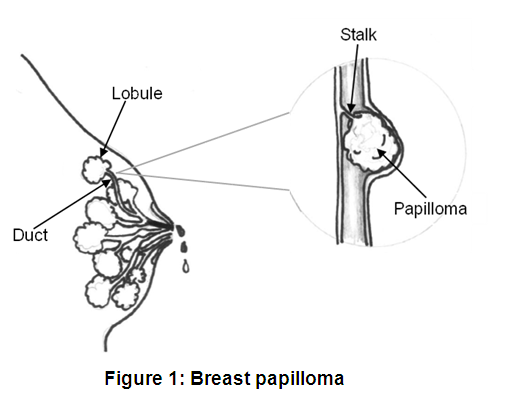Breast papillomas (or intraductal papillomas) are wart-like growths in a breast duct (see Figure 1). They are benign lesions (not cancerous). You can have 1 or more papillomas in a duct or in a few ducts. Breast papillomas are usually painless. There are no known causes and no risk factors linked to breast papillomas. It is not really known why some women get papillomas.

You may or may not be able to feel a breast papilloma. Breast papillomas are often found behind the nipple but they can be found elsewhere in the breast. The most common sign of a breast papilloma is a sudden and unexpected clear or bloody discharge from one nipple.
Breast papillomas most often affect women between the ages of 35 and 50. Women closer to menopause tend to have 1 papilloma, while younger women are more likely to have many papillomas in 1 or both breasts.
Breast papillomas are diagnosed most commonly with an ultrasound and may need a special x-ray called a galactogram.
A small sample is usually taken (called a core biopsy) to determine what the lesion is and the characteristics of it. Not all breast papillomas need to be removed by surgery. If surgery is needed, the duct and the papilloma are removed through a small cut made near the nipple and areola (the dark area around the nipple) or elsewhere on the breast as needed. You will have a local anesthetic to freeze the area before the cut is made. After the duct and papilloma are removed, they are sent to the lab to confirm that the growth is a papilloma.
After the results of the test (biopsy) are back, the surgeon will share the results with you and let you know if you need any further care or treatment.
